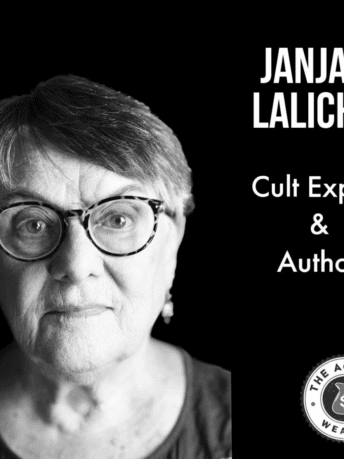This article originally appeared on popdust.com
Recently, you’ve probably read more about the disturbing prevalence of cults than you’ve ever wanted to, as 2019 has already featured more headlines about “cults”—especially “sex cults”—than any other previous year (according to analysts who break down what news most often ruins your mornings).
In January, Lifetime exposed R. Kelly’s alleged “sex cult” comprised of underage girls in his mansion. Last month, CW actress Allison Mack pleaded guilty for running Keith Raniere’s “sex-cult” in Albany after former members alleged that his “self-improvement organization for women,” NXIVM, blackmailed young women to be Raniere’s personal “slaves.” Now, another disturbing story has shined a spotlight on cult-like activities in the murky regions of upstate New York, this time at Sarah Lawrence College. Each story inevitably brings up the same questions: Who is susceptible to cult recruitment? Why do people stay? What is the appeal of a cult leader?
New York Magazine recently exposed a con-man’s manipulation of undergraduates at Sarah Lawrence, an insular liberal arts school. In 2010, Lawrence Ray moved into his daughter’s on-campus dorm after being released from prison for insurance fraud. He swiftly manipulated students into believing he was a former CIA operative and an ex-Marine who had developed a “core program of personal transformation.” Preying on the teenagers’ insecurities and quests for self-discovery, he maintained psychological control over his daughter and her classmates through bizarre versions of pseudo-therapy, leading to the teens’ financial, sexual, and emotional exploitation.
R. Kelly, NXIVM’s founder Keith Raniere, and Ray each accrued power through four basic cult tactics. Janja Lalich, a professor of sociology at California State University in Chico, told The Cut, “I think if there’s any common denominator, it’s idealism.” She elaborated, “People end up being in what I call a bounded reality. They’re in a different world from you and I. They’re in this very closed world, this other reality where that kind of evil became normalized. So the way that their own self-confidence and sense of morality was broken down over time is what allowed this to take place.”
To begin with, it’s a myth that cult recruits are necessarily mentally ill or weak-willed. Psychologists have long pointed out that most people can be susceptible to cult influence if they find themselves under certain types of duress. Research shows that financial stress, a lack of social support from friends or family, and emotional vulnerability stemming from prior abuse, a death in the family, or living away from home for the first time makes one a “prime target” for cult recruitment. When Ezra Marcus and James D. Walsh profiled Larry Ray, they described the students he indoctrinated into his ideology as “in some ways typical Sarah Lawrence students: an artistic, bookish group of introverts with good grades. (‘We’re different, so are you,’ goes one of the school’s slogans.) They were also sensitive and, in ways common to 19-year-olds, searching for guidance.”
Ray immediately “planted himself in the common area, cooking steak dinners and ordering expensive delivery for [his daughter] and her seven housemates.” One of the housemates later reflected, “He did all of our cleaning and definitely took on the dad role in the house in a big way.” It was typical behavior for a cult leader. An individual’s first encounter with a cult typically entails a form of “love-bombing,” which is a concerted effort by cult members to flatter, support, and validate a target. Cult awareness expert Ronald N. Loomis describes this practice on college campuses as “a recruiter approaching the student and doing everything [they] can to make the student feel special and unique. They’re quickly trying to convey the message that I am your new best friend. And they will fake mutual interests in order to give the impression that they share many things in common.”
Emotional and physical isolation only enhance that sense of trust and reliance. Both NXIVM and Larry Ray enjoyed strongholds in upstate New York: provincial areas where small-town ethos made social isolation easy. Marcus and Walsh noted, “Located just above the city limits of New York, Sarah Lawrence looks as if it had been plucked from a New England town and plopped 15 miles north of Times Square. It can feel whimsically sheltered, even more so than most liberal-arts colleges.” Geographical isolation, be it a sheltered student dorm or the confines of R. Kelly’s Georgia mansion, facilitate social alienation from friends and family, causing recruits to grow more dependent on a cult leader.
Above all, control is what keeps individuals trapped within a cycle of manipulation and exploitation. Most commonly, recruits are terrorized and “punished” for perceived slights against the leader (Ray is said to have sexually tortured at least one male student and forced others to have sex with him), and then they are ultimately “forgiven” and lavished with affection. Social psychologist Alexandra Stein explains, “When we are frightened, we don’t simply run away from the fear, but run to a safe haven, ‘to someone…’—and that someone is usually a person to whom we feel attached. But when the supposed safe haven is also the source of the fear, then running to that person is a failing strategy, causing the frightened person to freeze, trapped between approach and avoidance.”
NXIVM leaders and Ray also kept followers under their control through threats of blackmail. They both used pseudo-therapy sessions to manipulate followers into confessing their most private secrets, whether in the form of illicit photographs or stories of childhood trauma. Ray would alternate between accusing individuals of “sabotaging” his teachings in order to demand financial compensation and preying on traumatic memories to form toxic sexual relationships with young students.
Ray continued to live with two of his followers even after they graduated from Sarah Lawrence, with three others regularly visiting their shared apartment in Upper Manhattan. “Larry was a chameleon,” says one long-time acquaintance of Ray. “He could be a good ol’ boy or a patriot, or he’d pull out a pipe and fake glasses and he’d be an intellectual. He would juggle ten different people at the same time, telling each of them one piece of a story he wanted them to know and convincing them that he wanted them to be part of his master plan.”
Ray’s former friend and ex-NYC Police Commissioner Bernard Kerik describe the con-man as a “psychotic con man who has victimized every friend he’s ever had.” He adds, “It’s been close to 20 years since I last heard from him, yet his reign of terror continues.” Indeed, Ray has a long history of paranoia that includes claims that Kerik and Rudy Giuliani are conspiring against him. “It’s clear they want to kill us,” Ray told The Cut, “They’re arrogant, they’re violent, they’re terrible people.”
To date, the only legal action taken against Ray has been his landlord’s eviction of him in 2014; he counter-sued and won. While Ray, his daughter, and a few former followers deny the allegations against him, a number of students have since survived suicide attempts and sought counseling for ex-cult members. At least one former student is in hiding from Ray.
While unsettling headlines about “sex cults” inevitably shock and appall, exposing the inner workings of cults hopefully serves as calls to action. NXIVM’s Keith Raniere is scheduled to go to trial this week to face charges of sex trafficking, forced labor conspiracy, and child pornography. R. Kelly has been charged with 10 counts of aggravated sexual abuse; he recently put his release on bail in jeopardy when he missed a hearing, which his lawyers explained with the claim that the 52-year-old “suffers from a learning disability that adversely affects his ability to read […] In essence he cannot.” While Ray’s lawyer contests the claims in The Cut’s article, Ray, now 59 years old, admits to knowingly accepting a young woman’s earnings from prostitution; in fact, he was reportedly “pleased” with her “efforts to pay him back” for an alleged debt. It has yet to be determined if Ray will be charged with a crime.
July 26, 2024






